Eastern French Pyrenees - 22nd to 28th June 2012
Eastern French Pyrenees - 22nd to 28th June 2012
The following is a resumé of my recent trip to the French Pyrenees, where I spent six full days exploring the stunning environs around the spa town of Ax-les-Thermes, in Ariège.
The town lies at 750m altitude, and is surrounded by mountains all reaching well over 1500m, with several in the vicinity approaching 3000m. Given its southerly latitude and the fact that the area receives plenty of rainfall, it is unusually verdant even above 1800m (it's only once you exceed 2200m that the colour starts to drain away).
I'm pleased to say the weather was stunning almost throughout. Only on the day I arrived was it cloudy and although the second day started off the same way, the sun came out just prior to midday and never went back in, whilst temperatures soared into the nineties.
My trip to France last year gave me experience with some of the species likely to be found in this area, but there are a few I'd like a little help with ID-wise (mainly pyrgus and erebia), so please feel free to advise on those as well as passing any other comments.
The town lies at 750m altitude, and is surrounded by mountains all reaching well over 1500m, with several in the vicinity approaching 3000m. Given its southerly latitude and the fact that the area receives plenty of rainfall, it is unusually verdant even above 1800m (it's only once you exceed 2200m that the colour starts to drain away).
I'm pleased to say the weather was stunning almost throughout. Only on the day I arrived was it cloudy and although the second day started off the same way, the sun came out just prior to midday and never went back in, whilst temperatures soared into the nineties.
My trip to France last year gave me experience with some of the species likely to be found in this area, but there are a few I'd like a little help with ID-wise (mainly pyrgus and erebia), so please feel free to advise on those as well as passing any other comments.
Re: Eastern French Pyrenees - 22nd to 28th June 2012
Day 1 - Friday 22nd June
I caught the 10.52 train from Toulouse and arrived in Ax-les-Thermes just before 1pm. This rail journey is fairly nondescript until one gets to Pamiers, whereupon the landscape changes - the elevation becomes progressively more apparent and the countryside gets noticeably greener.
My base for the week was the Grande Cordée Hotel, and after sorting out all my things I ventured out to explore the immediate area at about 2.30pm.
It was cloudy and fairly cool (around 20c), and butterflies were hard to find. I decided to climb one of the rocky knolls near the ski-lift station to give me a better sense of my bearings, and it was here that I found my first butterfly - a Ringlet - which was closely followed by a couple of Marbled Whites and several Heath Fritillaries. Eventually, I came across my first non British species:
1. Provençal Fritillary
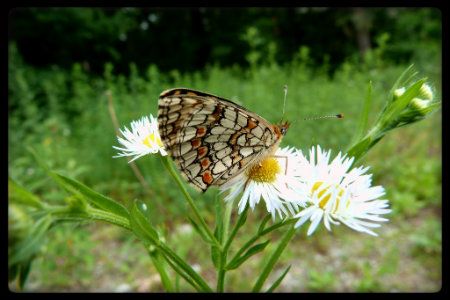
Hard to estimate how many were seen throughout my stay as they look a bit like Heaths (which are ubiquitous) at first glance. I certainly identified well into double figures.
Next up was a species that displays quite an element of sexual dimorphism for a fritillary:
2. Spotted Fritillary
This is a male:
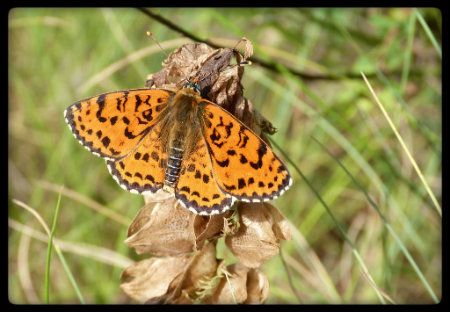
Female:
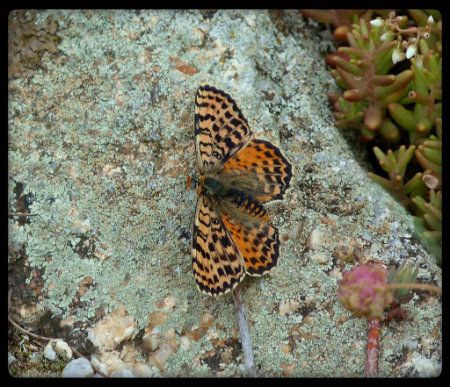
Underside (male):
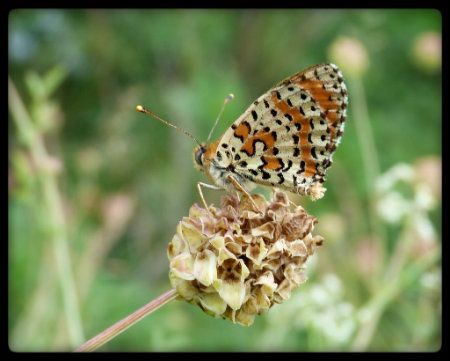
I probably saw about a hundred of these during the week.
The craggy knoll was shrub laden, and this provided habitat for several of the next species I saw:
3. Purple Shot Copper
These pugnacious little butterflies will battle with anything that flies anywhere near them; all you see is a flash of greyish copper before they zoom back down to their perch.
The males have a purplish hue to them (hence the name):
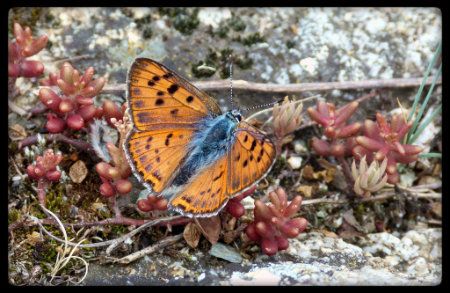
Personally, I prefer the females, as although they lack the purple tint, the ground colour is a richer copper shade:
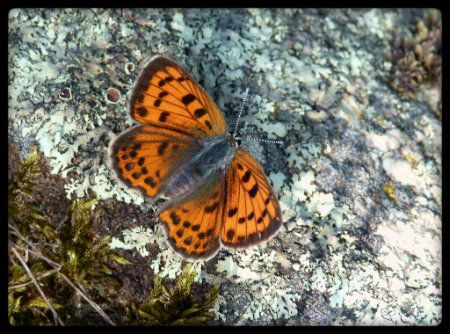
This species was fairly common depending on the terrain. Probably about 50 seen during my stay. The undersides are lovely too:

4. Black Veined White
This was pretty much the 'signature' butterfly of the week. They were everywhere - low down, high up, dry areas, damp areas, etc. You'd never see lots of them in a small area, but they were wide ranging and impossible to miss (I just love the white antennal tips):
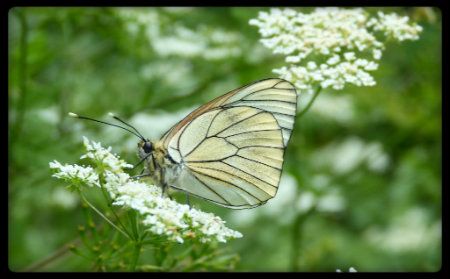
5. Pearly Heath
I came to think of this species as almost a default Hedge Brown, such were its habitat fancies and its sheer numbers. Multi hundreds seen throughout the week.
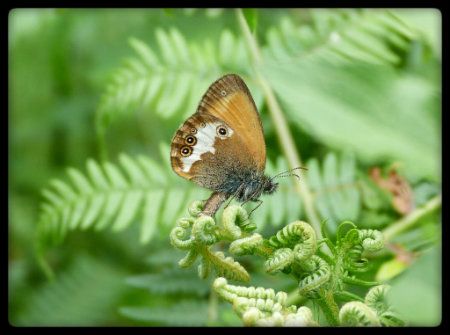
6. Large Wall Brown
Saw about 20 of these in total through the week, the first ones being found at the top of the crag where there was an old stone wall. They can be infuriating to approach though; it's almost as if they're wilfully playing cat and mouse with you. It took me FIVE whole days to get an open wing shot, and even then it was from a distance with a zoom. Grrr!
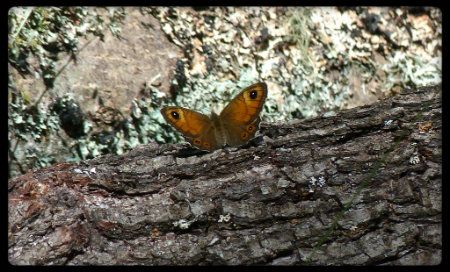
British species
Lots of Heath Fritillaries seen already, with Marbled Whites in fair numbers too. Ringlets and Meadow Browns appear common, whilst Clouded Yellow, Dark Green Fritillary, Green Veined, Small White, Small Copper seen too in small numbers.
Plenty of Large Skippers, with Small/Essex combined probably only just outstripping them. I checked quite a few 'Small' Skippers, and was surprised at how many were actually Essex (probably about a quarter).
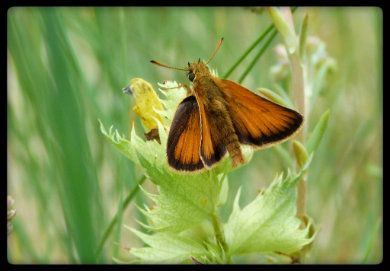
Daily miscellany
I think I'm going to like this hotel! Three course meal is on offer to guests at just 16 Euros. The only drawback is that it's a fixed menu, meaning that if there's something on it you don't like then you're a bit stuck. Fortunately, I very much liked carpacchio starters, followed by a duck main course and a chocolate dessert. The house wine is AOC Minervois too, and a litre of it is just 8 Euros!!
24 Euros well spent.........I reassure myself that I'll be burning the calories off rather quickly each subsequent day. We'll see.
I caught the 10.52 train from Toulouse and arrived in Ax-les-Thermes just before 1pm. This rail journey is fairly nondescript until one gets to Pamiers, whereupon the landscape changes - the elevation becomes progressively more apparent and the countryside gets noticeably greener.
My base for the week was the Grande Cordée Hotel, and after sorting out all my things I ventured out to explore the immediate area at about 2.30pm.
It was cloudy and fairly cool (around 20c), and butterflies were hard to find. I decided to climb one of the rocky knolls near the ski-lift station to give me a better sense of my bearings, and it was here that I found my first butterfly - a Ringlet - which was closely followed by a couple of Marbled Whites and several Heath Fritillaries. Eventually, I came across my first non British species:
1. Provençal Fritillary

Hard to estimate how many were seen throughout my stay as they look a bit like Heaths (which are ubiquitous) at first glance. I certainly identified well into double figures.
Next up was a species that displays quite an element of sexual dimorphism for a fritillary:
2. Spotted Fritillary
This is a male:

Female:

Underside (male):

I probably saw about a hundred of these during the week.
The craggy knoll was shrub laden, and this provided habitat for several of the next species I saw:
3. Purple Shot Copper
These pugnacious little butterflies will battle with anything that flies anywhere near them; all you see is a flash of greyish copper before they zoom back down to their perch.
The males have a purplish hue to them (hence the name):

Personally, I prefer the females, as although they lack the purple tint, the ground colour is a richer copper shade:

This species was fairly common depending on the terrain. Probably about 50 seen during my stay. The undersides are lovely too:

4. Black Veined White
This was pretty much the 'signature' butterfly of the week. They were everywhere - low down, high up, dry areas, damp areas, etc. You'd never see lots of them in a small area, but they were wide ranging and impossible to miss (I just love the white antennal tips):

5. Pearly Heath
I came to think of this species as almost a default Hedge Brown, such were its habitat fancies and its sheer numbers. Multi hundreds seen throughout the week.

6. Large Wall Brown
Saw about 20 of these in total through the week, the first ones being found at the top of the crag where there was an old stone wall. They can be infuriating to approach though; it's almost as if they're wilfully playing cat and mouse with you. It took me FIVE whole days to get an open wing shot, and even then it was from a distance with a zoom. Grrr!

British species
Lots of Heath Fritillaries seen already, with Marbled Whites in fair numbers too. Ringlets and Meadow Browns appear common, whilst Clouded Yellow, Dark Green Fritillary, Green Veined, Small White, Small Copper seen too in small numbers.
Plenty of Large Skippers, with Small/Essex combined probably only just outstripping them. I checked quite a few 'Small' Skippers, and was surprised at how many were actually Essex (probably about a quarter).

Daily miscellany
I think I'm going to like this hotel! Three course meal is on offer to guests at just 16 Euros. The only drawback is that it's a fixed menu, meaning that if there's something on it you don't like then you're a bit stuck. Fortunately, I very much liked carpacchio starters, followed by a duck main course and a chocolate dessert. The house wine is AOC Minervois too, and a litre of it is just 8 Euros!!
24 Euros well spent.........I reassure myself that I'll be burning the calories off rather quickly each subsequent day. We'll see.
Re: Eastern French Pyrenees - 22nd to 28th June 2012
I thoroughly enjoyed your French holiday trip report from last year David, it appears that this years is going to be equally as interesting, I cannot believe how quickly the past year has gone though  Some very impressive images and I mention it very quietly...you were actually in the dry
Some very impressive images and I mention it very quietly...you were actually in the dry  Looking forward to seeing Day 2 of your report.
Looking forward to seeing Day 2 of your report.
Bill
Bill
Why not visit my website at http://www.dragonfly-days.co.uk
- Padfield
- Administrator

- Posts: 8182
- Joined: Sun Nov 05, 2006 10:19 pm
- Location: Leysin, Switzerland
- Contact:
Re: Eastern French Pyrenees - 22nd to 28th June 2012
Yes, great pictures David! I am very much looking forward to the rest!
Guy
Guy
Guy's Butterflies: https://www.guypadfield.com
The Butterflies of Villars-Gryon : https://www.guypadfield.com/villarsgryonbook.html
The Butterflies of Villars-Gryon : https://www.guypadfield.com/villarsgryonbook.html
Re: Eastern French Pyrenees - 22nd to 28th June 2012
Day 2 - Saturday 23rd June
I got up at 8am but was most disappointed to see the same heavy cloud cover as had prevailed the afternoon before.
Having already experienced butterflies' reluctance to be active on such cloudy days in southern France, I decided to take my time and visit Ax town centre and see how things went later on.
Well, by 10.30am things had not improved, but I was determined to at least cover some ground to seek out potential hotspots for when the sun eventually arrived..........little did I know?!?
Whilst standing on the high crag yesterday, I had spotted a scrubby strip of land that seemed to go on forever. I wanted to visit this spot and take a look, and I duly managed to find a way to do so, albeit via a side road, a half mile walk up an unkempt path and a stroll underneath what appeared to be a major road....only it wasn't! All the preparatory work for a highway seemed to have been completed, yet the actual track looked to be at least 3 years neglected:
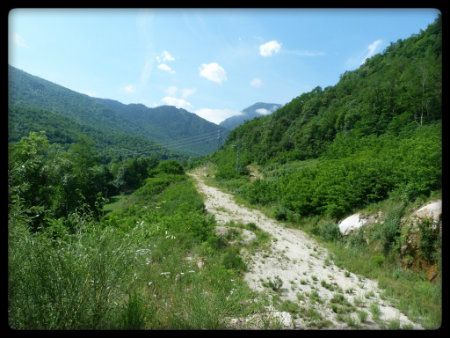
I did some research on this and it appears that a few years back work started on a major relief road to bypass Ax-les-Thermes and link it with Tarascon, 15 miles further north. The money dried up though and the 'road' has since become a white elephant. Two major bridges have been constructed and are ready for traffic right now.......the problem is that there's no road to link them, as can be seen from this shot I took from the mountain to the north of Ax on the 24th June:

The scar that you see on the right of the picture is this grand, yet uncompleted, construction project. One day I'm sure it will be finished, but in the meantime it presents a superb butterfly habitat, with steep banks on both sides and scrub and herbs growing in profusion. I was so pessimistic about the weather that I actually wore my jeans but within half an hour of arriving at this isolated (and probably illegal to access) site, the sun started breaking up the cloud cover and the temperatures (and butterfly activity) rose by several degrees.
7. Marbled Fritillary
Dark Greens were swooping about in numbers, but Marbled Fritillaries were just as commonplace, though to be certain of which was which you really needed them to either settle or pass very close to you whereupon you can see the detached sub-marginal triangles which readily distinguish Marbleds from Dark Greens. Marbleds were pretty common (maybe slightly less so than Dark Greens) but both seem to like patrolling around the bramble clad banks of this part of the world:
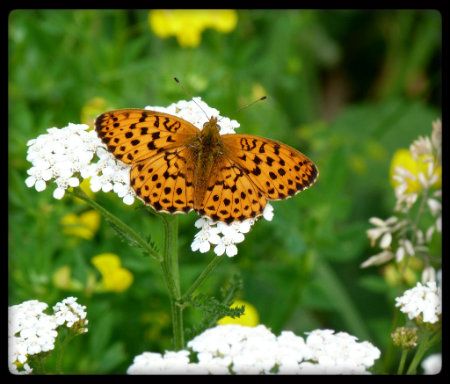
Then came a most exciting moment - a largeish sized Blue that I felt sure I'd never seen in my life before. True enough, I hadn't:
8. Long Tailed Blue
Striking undersides and lovely blue uppers with a prominent hindwing spot and a noticeable tail make this species very attractive indeed. I only saw 5 in the whole time I was here, three of them on this very morning. Here's a male:
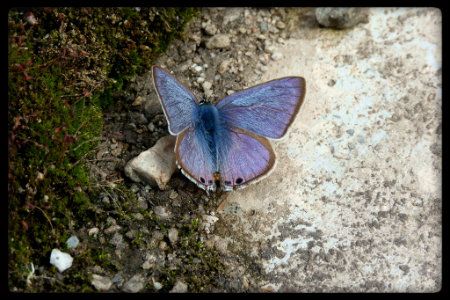
The cloud had by now almost completely dispersed and, imbued with enthusiasm, I climbed the bank and immediately found another Long Tailed Blue, this time a fresh female:
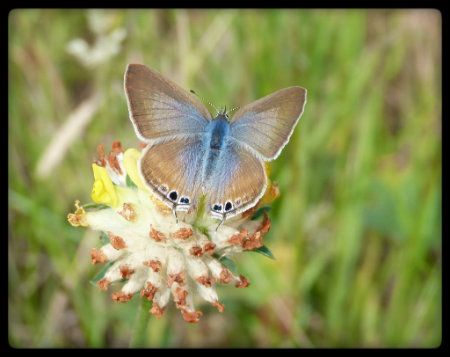
She was absolutely stunning, so....time for a 'Padfield' type underside shot:
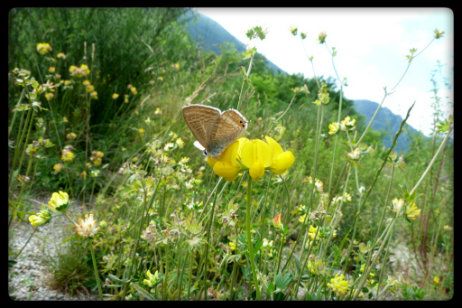
My senses were primed by now and anything blue in colour was investigated with vigour. Within minutes, something else that seemed most unusual passed by:
9. Lang's Short Tailed Blue
This was the only one I saw and with the sun now high in the sky and no longer being obscured by cloud photographing such a small specimen proved tricky. These were the best shots I could get of this female:
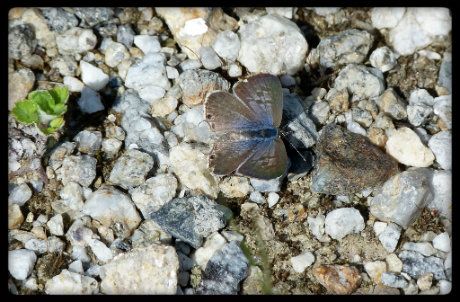
I have practically no knowledge of this species and wasn't expecting to encounter it here, so if anyone has experience of it I'd love to hear about it.
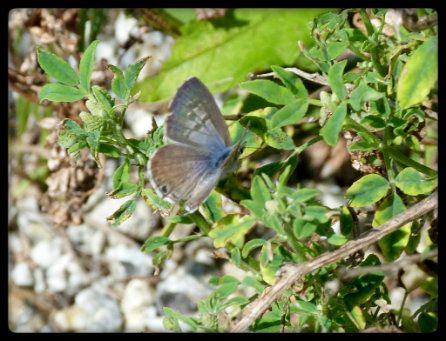
10. Queen of Spain Fritillary
I went back to my rucksack to take a drink of water but whilst I did so, I noticed a QoS nearby, one of 15 to 20 I saw during the week:
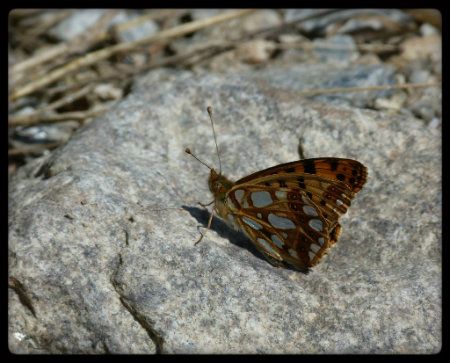
I then climbed one of the steep, man made embankments which were laden with shrubs. I wasn't surprised to see my first Hairstreak of the week:
11. Ilex Hairstreak
Hairstreaks were conspicuous by their relative absence around here. I only saw half a dozen of this species:
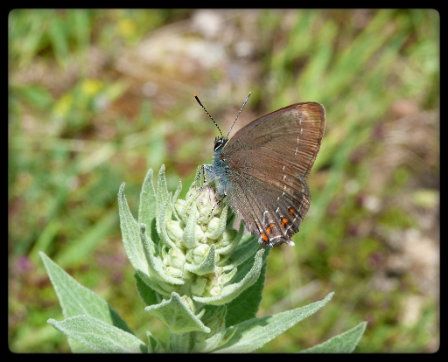
At the bottom of the embankment where the gravelly track began again, I noticed another unusual looking Blue. I'd already seen a handful of Common Blues, but something made me investigate this one and I was glad I did:
12. Turquoise Blue
This was the only one I saw and I cannot see anything in my Tolman and Lewington that it could be other than plebicula dorylas. Please feel free to over-rule me if you have any other suggestions.
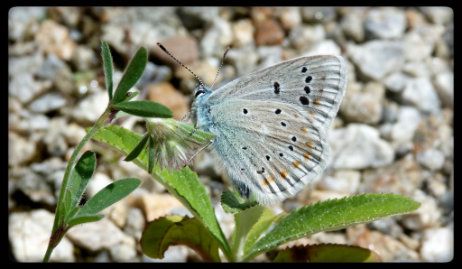
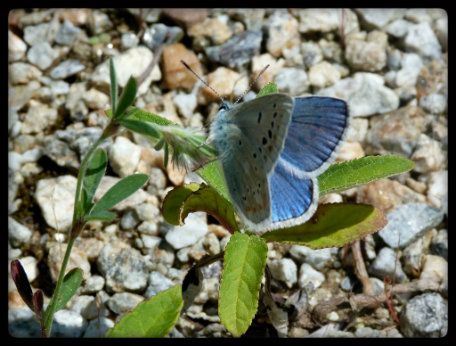
13. Great Banded Grayling
Sadly, the only species of Grayling I saw all week and, unlike last year in the Massif Central when I saw multi-hundreds, they were very few in number here (maybe it's early in the flight season). I saw just one in the first 5 days, two on the 6th day and three on the 7th day, including this one which, unusually for this species, chose to rest on a leaf rather than either a tree trunk or the ground:
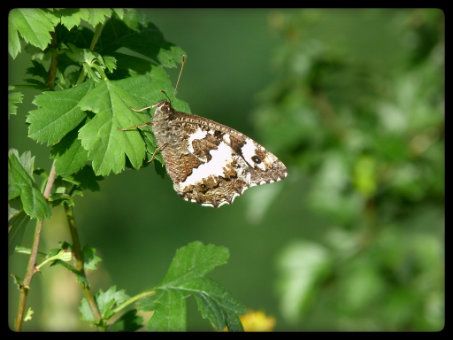
14. Sloe Hairstreak
Appalling photo...but then it was just a record shot as I felt confident I'd see many more (this species was practically approaching plague proportions in the Massif central last year).
Wrong. This was the only one I saw all week. Moral of the story.....?
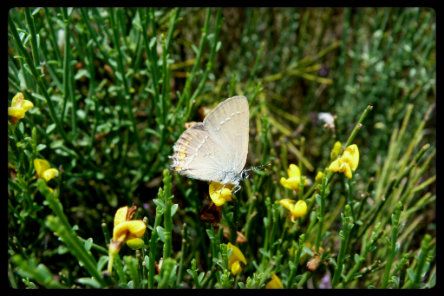
British species
Skippers all over the place...Large, Small, Essex and even two very faded Dingies. No Lulworths though, perhaps because the rock is neither chalk nor limestone. Wood Whites seem to be quite common, and not necessarily in woodland. There were a few flying up and down the open areas of the site I visited. Common Blues fairly numerous, with Small Heaths not far behind. Also seen Red Admiral, Comma, Small Tortoiseshell, Small Copper, Brimstone, Wall, Speckled Wood, White Admiral, Brown Argus, Silver Washed Fritillary plus a female Holly Blue in the hotel garden!
Daily Miscellany
I overheard the word canicule this evening. This is French for 'heatwave', and when I asked about it I was told to expect one immediately!! Apparently, like in the UK, spring and early summer has been appalling in this part of the world and just over a week ago it was still hovering around the 15/16c mark and wet to boot!
A British heatwave is usually anything mid-seventies and above. This southern French one threatens to break the one hundred barrier and it arrives tomorrow.
I got up at 8am but was most disappointed to see the same heavy cloud cover as had prevailed the afternoon before.
Having already experienced butterflies' reluctance to be active on such cloudy days in southern France, I decided to take my time and visit Ax town centre and see how things went later on.
Well, by 10.30am things had not improved, but I was determined to at least cover some ground to seek out potential hotspots for when the sun eventually arrived..........little did I know?!?
Whilst standing on the high crag yesterday, I had spotted a scrubby strip of land that seemed to go on forever. I wanted to visit this spot and take a look, and I duly managed to find a way to do so, albeit via a side road, a half mile walk up an unkempt path and a stroll underneath what appeared to be a major road....only it wasn't! All the preparatory work for a highway seemed to have been completed, yet the actual track looked to be at least 3 years neglected:

I did some research on this and it appears that a few years back work started on a major relief road to bypass Ax-les-Thermes and link it with Tarascon, 15 miles further north. The money dried up though and the 'road' has since become a white elephant. Two major bridges have been constructed and are ready for traffic right now.......the problem is that there's no road to link them, as can be seen from this shot I took from the mountain to the north of Ax on the 24th June:

The scar that you see on the right of the picture is this grand, yet uncompleted, construction project. One day I'm sure it will be finished, but in the meantime it presents a superb butterfly habitat, with steep banks on both sides and scrub and herbs growing in profusion. I was so pessimistic about the weather that I actually wore my jeans but within half an hour of arriving at this isolated (and probably illegal to access) site, the sun started breaking up the cloud cover and the temperatures (and butterfly activity) rose by several degrees.
7. Marbled Fritillary
Dark Greens were swooping about in numbers, but Marbled Fritillaries were just as commonplace, though to be certain of which was which you really needed them to either settle or pass very close to you whereupon you can see the detached sub-marginal triangles which readily distinguish Marbleds from Dark Greens. Marbleds were pretty common (maybe slightly less so than Dark Greens) but both seem to like patrolling around the bramble clad banks of this part of the world:

Then came a most exciting moment - a largeish sized Blue that I felt sure I'd never seen in my life before. True enough, I hadn't:
8. Long Tailed Blue
Striking undersides and lovely blue uppers with a prominent hindwing spot and a noticeable tail make this species very attractive indeed. I only saw 5 in the whole time I was here, three of them on this very morning. Here's a male:

The cloud had by now almost completely dispersed and, imbued with enthusiasm, I climbed the bank and immediately found another Long Tailed Blue, this time a fresh female:

She was absolutely stunning, so....time for a 'Padfield' type underside shot:

My senses were primed by now and anything blue in colour was investigated with vigour. Within minutes, something else that seemed most unusual passed by:
9. Lang's Short Tailed Blue
This was the only one I saw and with the sun now high in the sky and no longer being obscured by cloud photographing such a small specimen proved tricky. These were the best shots I could get of this female:

I have practically no knowledge of this species and wasn't expecting to encounter it here, so if anyone has experience of it I'd love to hear about it.

10. Queen of Spain Fritillary
I went back to my rucksack to take a drink of water but whilst I did so, I noticed a QoS nearby, one of 15 to 20 I saw during the week:

I then climbed one of the steep, man made embankments which were laden with shrubs. I wasn't surprised to see my first Hairstreak of the week:
11. Ilex Hairstreak
Hairstreaks were conspicuous by their relative absence around here. I only saw half a dozen of this species:

At the bottom of the embankment where the gravelly track began again, I noticed another unusual looking Blue. I'd already seen a handful of Common Blues, but something made me investigate this one and I was glad I did:
12. Turquoise Blue
This was the only one I saw and I cannot see anything in my Tolman and Lewington that it could be other than plebicula dorylas. Please feel free to over-rule me if you have any other suggestions.


13. Great Banded Grayling
Sadly, the only species of Grayling I saw all week and, unlike last year in the Massif Central when I saw multi-hundreds, they were very few in number here (maybe it's early in the flight season). I saw just one in the first 5 days, two on the 6th day and three on the 7th day, including this one which, unusually for this species, chose to rest on a leaf rather than either a tree trunk or the ground:

14. Sloe Hairstreak
Appalling photo...but then it was just a record shot as I felt confident I'd see many more (this species was practically approaching plague proportions in the Massif central last year).
Wrong. This was the only one I saw all week. Moral of the story.....?

British species
Skippers all over the place...Large, Small, Essex and even two very faded Dingies. No Lulworths though, perhaps because the rock is neither chalk nor limestone. Wood Whites seem to be quite common, and not necessarily in woodland. There were a few flying up and down the open areas of the site I visited. Common Blues fairly numerous, with Small Heaths not far behind. Also seen Red Admiral, Comma, Small Tortoiseshell, Small Copper, Brimstone, Wall, Speckled Wood, White Admiral, Brown Argus, Silver Washed Fritillary plus a female Holly Blue in the hotel garden!
Daily Miscellany
I overheard the word canicule this evening. This is French for 'heatwave', and when I asked about it I was told to expect one immediately!! Apparently, like in the UK, spring and early summer has been appalling in this part of the world and just over a week ago it was still hovering around the 15/16c mark and wet to boot!
A British heatwave is usually anything mid-seventies and above. This southern French one threatens to break the one hundred barrier and it arrives tomorrow.
Last edited by David M on Sun Jul 01, 2012 9:48 am, edited 2 times in total.
- Padfield
- Administrator

- Posts: 8182
- Joined: Sun Nov 05, 2006 10:19 pm
- Location: Leysin, Switzerland
- Contact:
Re: Eastern French Pyrenees - 22nd to 28th June 2012
Hi David,
Great continuation - I wish I were there!
You are, of course, right with the turquoise blue.
You asked about Lang's short-tailed blue. Like the long-tailed blue this is a Mediterranean species that can be seen north of its true breeding range as a migrant. However, it seems to cling more tightly to the Mediterranean and rapidly gets increasingly rare further north. I see long-tailed blue commonly in August and September in Switzerland but have yet to see Lang's here. It is regular in the central Pyrenees, where I often camp, up to about 1000m and occasionally higher.
Guy
Great continuation - I wish I were there!
You are, of course, right with the turquoise blue.
You asked about Lang's short-tailed blue. Like the long-tailed blue this is a Mediterranean species that can be seen north of its true breeding range as a migrant. However, it seems to cling more tightly to the Mediterranean and rapidly gets increasingly rare further north. I see long-tailed blue commonly in August and September in Switzerland but have yet to see Lang's here. It is regular in the central Pyrenees, where I often camp, up to about 1000m and occasionally higher.
Guy
Guy's Butterflies: https://www.guypadfield.com
The Butterflies of Villars-Gryon : https://www.guypadfield.com/villarsgryonbook.html
The Butterflies of Villars-Gryon : https://www.guypadfield.com/villarsgryonbook.html
Re: Eastern French Pyrenees - 22nd to 28th June 2012
Thanks, Guy.
Yes, I see from the distribution maps that Lang's is very much a mediterranean species. Lovely little butterfly with beautiful undersides that, sadly, I didn't manage to photograph.
Yes, I see from the distribution maps that Lang's is very much a mediterranean species. Lovely little butterfly with beautiful undersides that, sadly, I didn't manage to photograph.
- Roger Gibbons
- Posts: 1106
- Joined: Wed Nov 29, 2006 5:29 pm
- Location: Hatfield, Herts
- Contact:
Re: Eastern French Pyrenees - 22nd to 28th June 2012
I don't have any books with me (I am travelling) but I wonder if the dorylas might be niviscens. I have no particular reason to think that other than it looks a little pale for dorylas, but I have never seen niviscens. Might be worth checking. Just a thought.
Re: Eastern French Pyrenees - 22nd to 28th June 2012
I'd be delighted to swap it for niviscens, Roger. Thanks for the input.Roger Gibbons wrote:I don't have any books with me (I am travelling) but I wonder if the dorylas might be niviscens. I have no particular reason to think that other than it looks a little pale for dorylas, but I have never seen niviscens. Might be worth checking. Just a thought.
Unfamiliar as I am with both species, I can only say that, upon reflection, I still think it is dorylas given that a) I almost didn't bother checking it out as its ground colour was sufficiently deep to make me assume it was a Common Blue, and b) it was found at a low level on the outskirts of the town (my guides suggest niviscens has a range of 1000-2000m).
Re: Eastern French Pyrenees - 22nd to 28th June 2012
Day 3 - Sunday 24th June
I was up and out by 8 o'clock this morning anxious to have completed my 1300m ascent before the anticipated canicule began.
I made my way via a charming little village called Ignaux to the foothills below Col du Chioula, and within a couple of hours I had a fabulous view over the bottom of the valley:
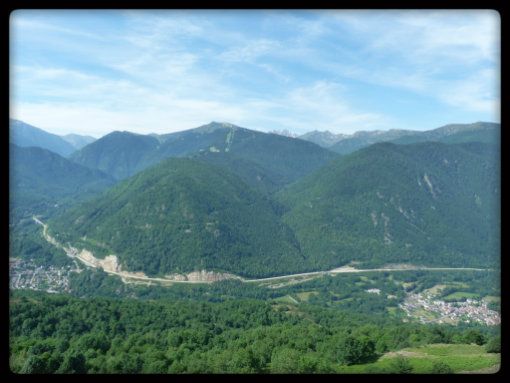
Large Wall Browns were cavorting with standard Wall Browns on the rocky outcrops, and this made for an entertaining pause before I headed on towards Refuge du Chioula. The terrain was largely heathland, but the altitude meant that the bracken looked like it had been frozen in UK time since mid May. The fronds were still less than waist high, and along with the abundant flowering broom this all made for a lovely aroma as I walked ever upwards.
Black Veined Whites were with me at every turn, whilst Dark Green Fritillaries were constant companions. I did see a few new species around here though:
15. Weaver's Fritillary
Only example I saw, which means the images aren't great:


Up until this point, I hadn't seen any pyrgus, but there were a fair number of them buzzing round the low growing plants amongst the grass. They were very active and tricky to photograph, and I'm happy to accept any suggestions vis-à-vis identity:
16. Oberthur's Skipper*
I'm going to hazard a guess at Carline Skipper for this one. My Tolman claims the upperside forewing cell spots form a 'c' shape and the hindwing markings are rather obscure, which appears to be the case with both this and two or three others I saw and photographed.
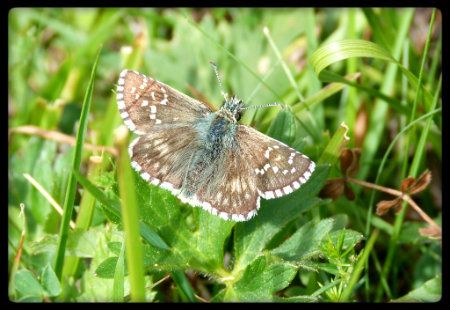
17. Olive Skipper*
Really struggling with this one. It was a similar size to 15a but has fewer upf spots.
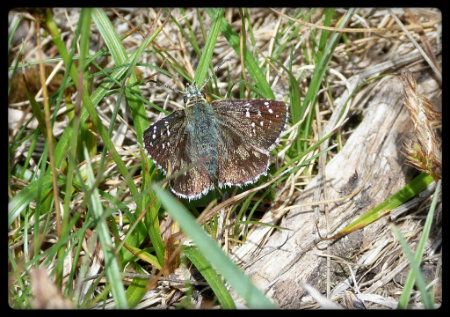
Lurking along the wooded edge of the path was my first erebia:
18. Piedmont Ringlet
This species can be found at low levels too - I saw several in Ax-les-Thermes itself during the week, along with many dozens more at higher altitude.
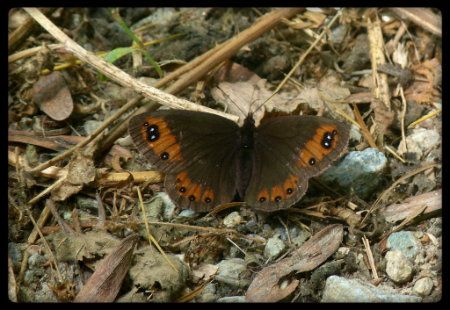
I only got up to about 1350m, and with things turning rather warm, I decided to go back down rather than risk burning myself out with 4 days of my trip still left. I took one last glorious view to the south west (where there was still plenty of ice near the summits of the mountains):
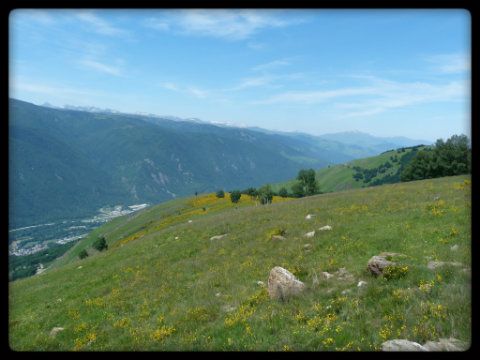
It took over an hour to get back to the road by Ignaux, although it was here, in a little scrubby lay-by, that I saw the only two examples all week of the following species:
19. Sooty Copper
Two males scrapping it out over a 10m x 3m stretch of grassland. None seen anywhere else in 7 days.
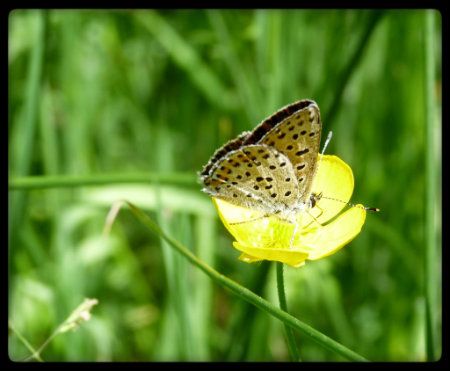
British species
Heath Fritillaries in silly numbers; Small Heaths abundant too and Dark Green Fritillaries into the high dozens. Small Coppers every 50 yards or so and even a couple of Swallowtails.
The biggest surprise was seeing decent numbers of Silver Studded Blues on the higher slopes amongst the heathland.
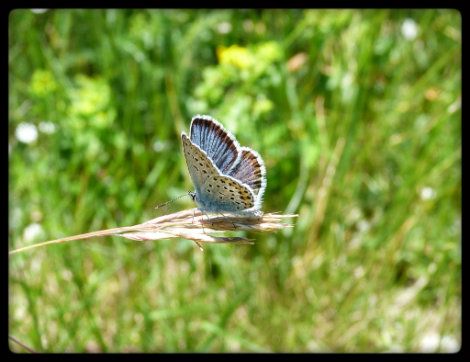
Daily Miscellany
My legs are utterly dependable but after just one day of climbing my feet sont déjà foutus!! I'm keeping on the flat tomorrow to give them a break and hopefully they'll be ready for my climb up to the plateau du saquet on Tuesday. Am I the only one who finds it harder on the feet coming down rather than going up? Bloody great blister on my next to little right toe which I dare not interfere with as it could adversely affect the rest of my holiday if it bursts.
*Thanks to Guy and Roger for the ID
I was up and out by 8 o'clock this morning anxious to have completed my 1300m ascent before the anticipated canicule began.
I made my way via a charming little village called Ignaux to the foothills below Col du Chioula, and within a couple of hours I had a fabulous view over the bottom of the valley:

Large Wall Browns were cavorting with standard Wall Browns on the rocky outcrops, and this made for an entertaining pause before I headed on towards Refuge du Chioula. The terrain was largely heathland, but the altitude meant that the bracken looked like it had been frozen in UK time since mid May. The fronds were still less than waist high, and along with the abundant flowering broom this all made for a lovely aroma as I walked ever upwards.
Black Veined Whites were with me at every turn, whilst Dark Green Fritillaries were constant companions. I did see a few new species around here though:
15. Weaver's Fritillary
Only example I saw, which means the images aren't great:


Up until this point, I hadn't seen any pyrgus, but there were a fair number of them buzzing round the low growing plants amongst the grass. They were very active and tricky to photograph, and I'm happy to accept any suggestions vis-à-vis identity:
16. Oberthur's Skipper*
I'm going to hazard a guess at Carline Skipper for this one. My Tolman claims the upperside forewing cell spots form a 'c' shape and the hindwing markings are rather obscure, which appears to be the case with both this and two or three others I saw and photographed.

17. Olive Skipper*
Really struggling with this one. It was a similar size to 15a but has fewer upf spots.

Lurking along the wooded edge of the path was my first erebia:
18. Piedmont Ringlet
This species can be found at low levels too - I saw several in Ax-les-Thermes itself during the week, along with many dozens more at higher altitude.

I only got up to about 1350m, and with things turning rather warm, I decided to go back down rather than risk burning myself out with 4 days of my trip still left. I took one last glorious view to the south west (where there was still plenty of ice near the summits of the mountains):

It took over an hour to get back to the road by Ignaux, although it was here, in a little scrubby lay-by, that I saw the only two examples all week of the following species:
19. Sooty Copper
Two males scrapping it out over a 10m x 3m stretch of grassland. None seen anywhere else in 7 days.

British species
Heath Fritillaries in silly numbers; Small Heaths abundant too and Dark Green Fritillaries into the high dozens. Small Coppers every 50 yards or so and even a couple of Swallowtails.
The biggest surprise was seeing decent numbers of Silver Studded Blues on the higher slopes amongst the heathland.

Daily Miscellany
My legs are utterly dependable but after just one day of climbing my feet sont déjà foutus!! I'm keeping on the flat tomorrow to give them a break and hopefully they'll be ready for my climb up to the plateau du saquet on Tuesday. Am I the only one who finds it harder on the feet coming down rather than going up? Bloody great blister on my next to little right toe which I dare not interfere with as it could adversely affect the rest of my holiday if it bursts.
*Thanks to Guy and Roger for the ID
Last edited by David M on Thu Jul 05, 2012 3:30 pm, edited 1 time in total.
- Padfield
- Administrator

- Posts: 8182
- Joined: Sun Nov 05, 2006 10:19 pm
- Location: Leysin, Switzerland
- Contact:
Re: Eastern French Pyrenees - 22nd to 28th June 2012
Hi David. Without undersides this is speculation, as usual, but for your skippers I'd suggest Oberthür's for the first and olive for the second. The second is clearly a female. The sparse markings are quite typical for female olive skippers in the Pyrenees, particularly the lack of a spot at the base of s.1 on the forewing. The butterfly has the 'feel' of this species.
If you had any undersides - even poor shots - I'd go further in my analysis, but I suspect you would have posted them if you had.
Guy
If you had any undersides - even poor shots - I'd go further in my analysis, but I suspect you would have posted them if you had.
Guy
Guy's Butterflies: https://www.guypadfield.com
The Butterflies of Villars-Gryon : https://www.guypadfield.com/villarsgryonbook.html
The Butterflies of Villars-Gryon : https://www.guypadfield.com/villarsgryonbook.html
Re: Eastern French Pyrenees - 22nd to 28th June 2012
Sadly, the butterflies were all settling with wings open so I got no underside shots at all.padfield wrote:Hi David. Without undersides this is speculation, as usual, but for your skippers I'd suggest Oberthür's for the first and olive for the second. The second is clearly a female. The sparse markings are quite typical for female olive skippers in the Pyrenees, particularly the lack of a spot at the base of s.1 on the forewing. The butterfly has the 'feel' of this species.
If you had any undersides - even poor shots - I'd go further in my analysis, but I suspect you would have posted them if you had.
Guy
I see what you mean regarding Olive Skipper and there WAS plenty of potentilla up on that hillside.
As for Oberthur's, it depends on whether you consider the uph markings to be conspicuous or obscure. My Tolman is telling me Oberthurs' are conspicuous whilst Carline's are obscure. To me the actual butterfly I photographed has obscure markings, but of course that's a matter of personal opinion based on experience, and I'm afraid mine is found much lacking when it comes to pyrgus. All I can do is post the full sized photo. If you feel those uph markings are conspicuous then certainly the upf markings fit in with Oberthur's:
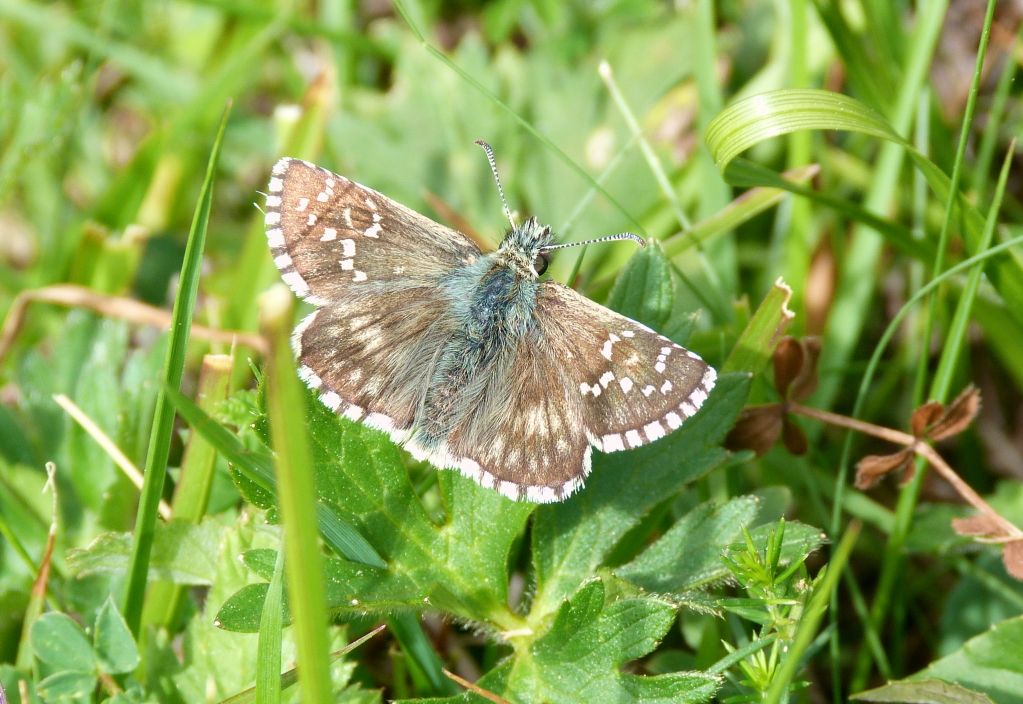
- Padfield
- Administrator

- Posts: 8182
- Joined: Sun Nov 05, 2006 10:19 pm
- Location: Leysin, Switzerland
- Contact:
Re: Eastern French Pyrenees - 22nd to 28th June 2012
It's not just the obscurity or otherwise but also the pattern. Your first butterfly is not bright and well demarcated, like some Oberthür's, but it does have the right shaped markings on the hindwing. That said, my experience of this species is much more limited than Roger's and he might have something to say on the matter! The butterfly looks nothing like Swiss Carline skippers, with which I am very familiar.
Guy
Guy
Guy's Butterflies: https://www.guypadfield.com
The Butterflies of Villars-Gryon : https://www.guypadfield.com/villarsgryonbook.html
The Butterflies of Villars-Gryon : https://www.guypadfield.com/villarsgryonbook.html
- Roger Gibbons
- Posts: 1106
- Joined: Wed Nov 29, 2006 5:29 pm
- Location: Hatfield, Herts
- Contact:
Re: Eastern French Pyrenees - 22nd to 28th June 2012
I have just noticed the second dorylas photo, the blue upperside, which – had I seen it - would have saved me from suggesting niviscens.
I agree 100% with armoricanus and serratulae. I would say these are about as clear-cut as Pyrgus ever gets. The carlinae “C” cell spot is rather variable and sometimes requires a leap of faith to accept that the shape is a C, sometimes more a < type of shape, but always more pronounced than on your one David. Don’t take the Tolman terms too literally – sometimes obscure means you can hardly see them and conspicuous just means not quite as obscure as the obscure ones. And all species are prone to variation.
I agree 100% with armoricanus and serratulae. I would say these are about as clear-cut as Pyrgus ever gets. The carlinae “C” cell spot is rather variable and sometimes requires a leap of faith to accept that the shape is a C, sometimes more a < type of shape, but always more pronounced than on your one David. Don’t take the Tolman terms too literally – sometimes obscure means you can hardly see them and conspicuous just means not quite as obscure as the obscure ones. And all species are prone to variation.
- Padfield
- Administrator

- Posts: 8182
- Joined: Sun Nov 05, 2006 10:19 pm
- Location: Leysin, Switzerland
- Contact:
Re: Eastern French Pyrenees - 22nd to 28th June 2012
Re the dorylas - I have found some extremely pale specimens in the Pyrenees. This one from last year is a case in point - and the upperside shows it is fresh, not simply worn pale:
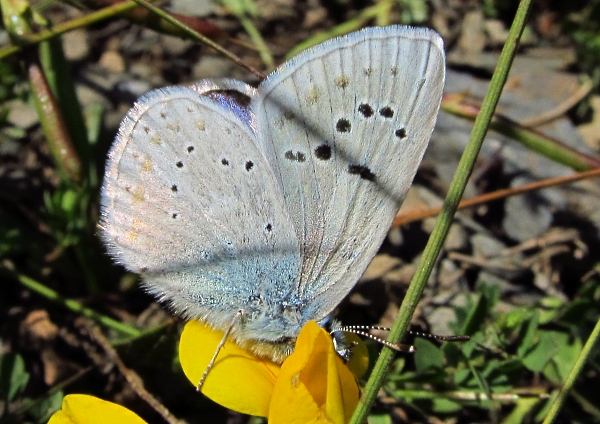
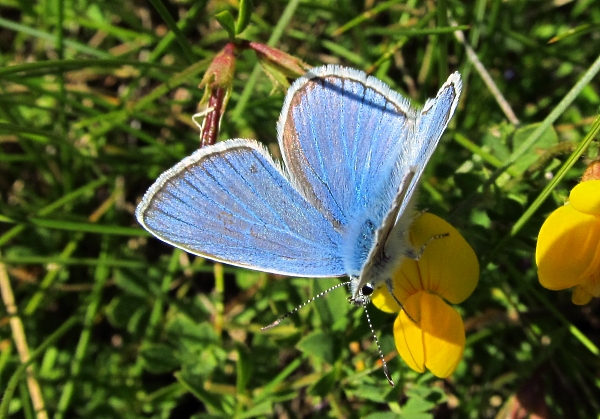
Guy


Guy
Guy's Butterflies: https://www.guypadfield.com
The Butterflies of Villars-Gryon : https://www.guypadfield.com/villarsgryonbook.html
The Butterflies of Villars-Gryon : https://www.guypadfield.com/villarsgryonbook.html
Re: Eastern French Pyrenees - 22nd to 28th June 2012
Roger/Guy - thanks ever so much for the advice. I had no idea regarding the Olive Skipper so I accept your respective diagnoses.
As for the Carline/Oberthurs situation, all I can say is that time spent in the field looking at live specimens is the only way to establish a reliable technique. To me, the guide is ambiguous in the sense that it is inviting me - the observer - to make my own mind up regarding what I deem 'conspicuous' and what I deem 'obscure', based in the main on drawings of long dead specimens.
I have 4 or 5 more pyrgus to publish, which I will do from Wednesday as I am in Abergavenny right now and won't return home to Swansea for another couple of days.
I like the Turquoise Blue shot, Guy - it really was an unexpected find for me last week (I'd hitherto never paid it any attention in the guide books).Is it rare?
As for the Carline/Oberthurs situation, all I can say is that time spent in the field looking at live specimens is the only way to establish a reliable technique. To me, the guide is ambiguous in the sense that it is inviting me - the observer - to make my own mind up regarding what I deem 'conspicuous' and what I deem 'obscure', based in the main on drawings of long dead specimens.
I have 4 or 5 more pyrgus to publish, which I will do from Wednesday as I am in Abergavenny right now and won't return home to Swansea for another couple of days.
I like the Turquoise Blue shot, Guy - it really was an unexpected find for me last week (I'd hitherto never paid it any attention in the guide books).Is it rare?
- Roger Gibbons
- Posts: 1106
- Joined: Wed Nov 29, 2006 5:29 pm
- Location: Hatfield, Herts
- Contact:
Re: Eastern French Pyrenees - 22nd to 28th June 2012
I should add that the carlinae C-shaped cell spot only applies to the male. The female can have a sort-of C cell spot but can also have a very lightly marked forewing with little or no cell spot. The books just don’t give you the full picture. Mind you, a 300-page tome on identifying Pyrgus maybe isn’t a publisher’s dream…
Re: Eastern French Pyrenees - 22nd to 28th June 2012
Day 4 - Monday 25th June
Out just after 8.00 this morning to follow the trail along the vallée d'Orlu, which had one particularly attractive feature - it is largely flat!!
I walked along the road at first because butterflies don't really get active here till after 9am. The scenery was stunning as per usual.
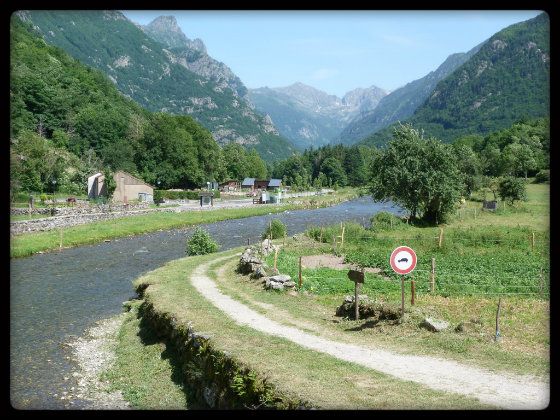
The first butterfly I saw was just beyond Orlu, in a damp field near the river. It was about 9.15am and I wasn't sure whether it was flying weakly because it hadn't warmed up properly or because it was a species that has a naturally weak flight. I perhaps wouldn't have bothered checking it any further had it not been a fritillary, but I jumped into the field and realised it was something new:
20. Lesser Marbled Fritillary

In the text books it looks hard to distinguish this species from Marbled Fritillary, but in truth the differences are obvious. Lesser Marbleds are appreciably smaller and weaker and more fluttery in flight. They are also more attracted to dampish environments, much like our Small Pearl Bordereds (which, incidentally, were flying with them in this area).
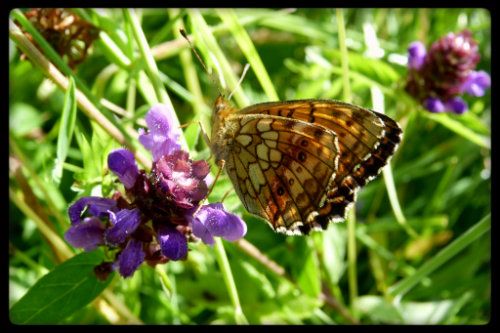
20a. .......... Skipper
This pyrgus was found in a drier field on the opposite side of the road. I'm wondering whether this could be another Olive Skipper given the scanty upf markings:
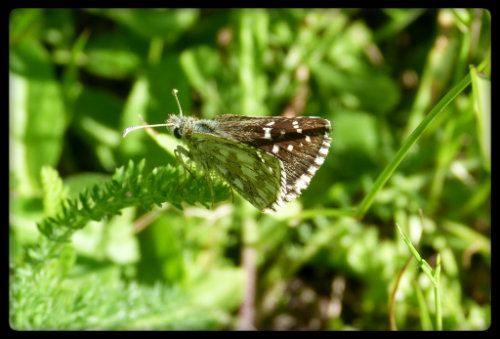
20b ........ Skipper
Given what has preceded this, I would suggest that this next 'mystery' pyrgus might also be Oberthur's?

That second pyrgus was found (along with hundreds of other butterflies), on a patch of light woodland and scrub situated virtually opposite the electricity company's factory:
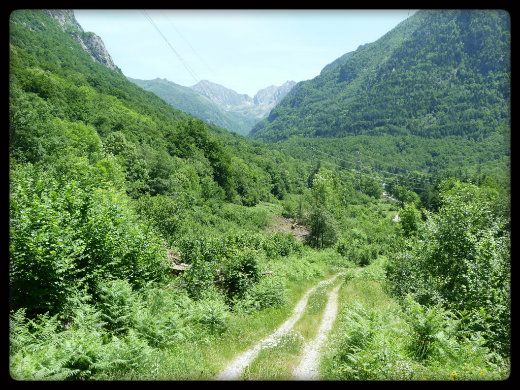
It was simply intoxicating to stand on that track and watch the phenomenal numbers of butterflies fluttering around the shrubs and amongst the grasses - it was actually almost impossible to concentrate on single specimens as within seconds other butterflies would pass by and interfere with the one you were studying. Still, there were moments of success:
21. Mazarine Blue*
Tiny little thing, barely larger than a Small Blue (and similarly marked undersides)
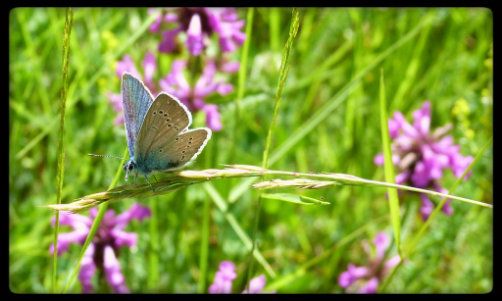
22. Tufted Marbled Skipper*
Chunky little things these. Very moth-like.
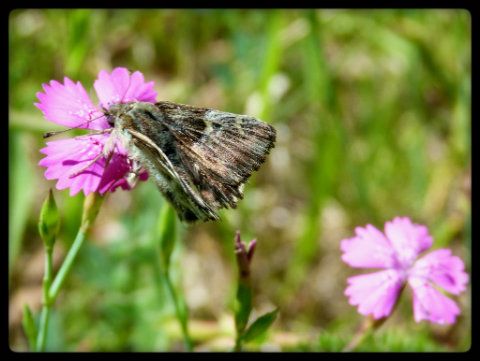
I moved on and visited the wolf sanctuary at the end of the track. I paid 8 Euros to get in, but saw no wolves (although I did hear them howling)!
It was nice to get in the shade however, and there was a little zoo with rabbits, goats, miniature pigs, poultry, etc. This recently born goat was particularly cute:
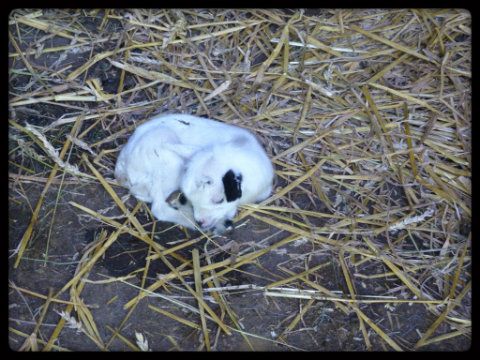
It was early afternoon by the time I left, and with me being on the valley floor it was oppressively hot - certainly in the nineties. I walked back along the track by the river and spotted this bird out fishing (is it a dipper?)
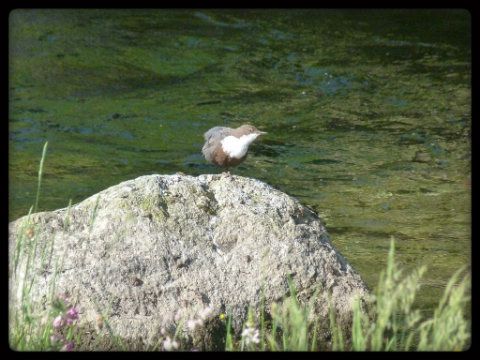
Huge numbers of butterflies all the way back to Ax which surprised me given how hot it was. I saw a great little spot near the Lac de Campauleil, but I was too drained to stop by and check it out, instead saving it in the memory bank for another day.
British species
Small Pearl Bordered Fritillaries were out in force in the damper parts around the river near Orlu. Probably 30+ seen:
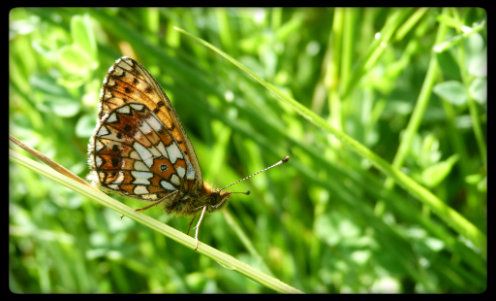
Perhaps the biggest shock though was seeing 4 male Orange Tips along the roadside vegetation. I guess with the Pyrenees still being frozen until late March, spring species there actually emerge later than ours do in the UK.
Daily miscellany
Water! It's everywhere in this part of the Pyrenees. In spite of the scorching temperatures (33c today and set to rise further), there's still huge amounts of water cascading down the mountainsides and dribbling through drainage channels to lower levels. There are gullies by the roadsides over here, and the purpose of these must be to drain the water away from the road surfaces. The principal beneficiaries are the roadside verge plants, which are unbelievably lush and green. I seemed to be stopping every 2 or 3 minutes to admire the colours on both sides of the road, along with the many butterflies that were naturally attracted to this vegetation. Breathtaking stuff.
*Thanks to Guy for the ID corrections
Out just after 8.00 this morning to follow the trail along the vallée d'Orlu, which had one particularly attractive feature - it is largely flat!!
I walked along the road at first because butterflies don't really get active here till after 9am. The scenery was stunning as per usual.

The first butterfly I saw was just beyond Orlu, in a damp field near the river. It was about 9.15am and I wasn't sure whether it was flying weakly because it hadn't warmed up properly or because it was a species that has a naturally weak flight. I perhaps wouldn't have bothered checking it any further had it not been a fritillary, but I jumped into the field and realised it was something new:
20. Lesser Marbled Fritillary

In the text books it looks hard to distinguish this species from Marbled Fritillary, but in truth the differences are obvious. Lesser Marbleds are appreciably smaller and weaker and more fluttery in flight. They are also more attracted to dampish environments, much like our Small Pearl Bordereds (which, incidentally, were flying with them in this area).

20a. .......... Skipper
This pyrgus was found in a drier field on the opposite side of the road. I'm wondering whether this could be another Olive Skipper given the scanty upf markings:

20b ........ Skipper
Given what has preceded this, I would suggest that this next 'mystery' pyrgus might also be Oberthur's?

That second pyrgus was found (along with hundreds of other butterflies), on a patch of light woodland and scrub situated virtually opposite the electricity company's factory:

It was simply intoxicating to stand on that track and watch the phenomenal numbers of butterflies fluttering around the shrubs and amongst the grasses - it was actually almost impossible to concentrate on single specimens as within seconds other butterflies would pass by and interfere with the one you were studying. Still, there were moments of success:
21. Mazarine Blue*
Tiny little thing, barely larger than a Small Blue (and similarly marked undersides)

22. Tufted Marbled Skipper*
Chunky little things these. Very moth-like.

I moved on and visited the wolf sanctuary at the end of the track. I paid 8 Euros to get in, but saw no wolves (although I did hear them howling)!
It was nice to get in the shade however, and there was a little zoo with rabbits, goats, miniature pigs, poultry, etc. This recently born goat was particularly cute:

It was early afternoon by the time I left, and with me being on the valley floor it was oppressively hot - certainly in the nineties. I walked back along the track by the river and spotted this bird out fishing (is it a dipper?)

Huge numbers of butterflies all the way back to Ax which surprised me given how hot it was. I saw a great little spot near the Lac de Campauleil, but I was too drained to stop by and check it out, instead saving it in the memory bank for another day.
British species
Small Pearl Bordered Fritillaries were out in force in the damper parts around the river near Orlu. Probably 30+ seen:

Perhaps the biggest shock though was seeing 4 male Orange Tips along the roadside vegetation. I guess with the Pyrenees still being frozen until late March, spring species there actually emerge later than ours do in the UK.
Daily miscellany
Water! It's everywhere in this part of the Pyrenees. In spite of the scorching temperatures (33c today and set to rise further), there's still huge amounts of water cascading down the mountainsides and dribbling through drainage channels to lower levels. There are gullies by the roadsides over here, and the purpose of these must be to drain the water away from the road surfaces. The principal beneficiaries are the roadside verge plants, which are unbelievably lush and green. I seemed to be stopping every 2 or 3 minutes to admire the colours on both sides of the road, along with the many butterflies that were naturally attracted to this vegetation. Breathtaking stuff.
*Thanks to Guy for the ID corrections
Last edited by David M on Sat Jul 07, 2012 4:37 pm, edited 2 times in total.
- Padfield
- Administrator

- Posts: 8182
- Joined: Sun Nov 05, 2006 10:19 pm
- Location: Leysin, Switzerland
- Contact:
Re: Eastern French Pyrenees - 22nd to 28th June 2012
Hi David,
Your Osiris blue is mazarine. The hindwing markings are definitive, but I can't illustrate them here as I'm in a bar at a station! Mazarine blue can be surprisingly small, while Osiris is typically the size of common blue.
The mallow skipper is tufted marbled, you'll probably be pleased to know!
Guy
Your Osiris blue is mazarine. The hindwing markings are definitive, but I can't illustrate them here as I'm in a bar at a station! Mazarine blue can be surprisingly small, while Osiris is typically the size of common blue.
The mallow skipper is tufted marbled, you'll probably be pleased to know!
Guy
Guy's Butterflies: https://www.guypadfield.com
The Butterflies of Villars-Gryon : https://www.guypadfield.com/villarsgryonbook.html
The Butterflies of Villars-Gryon : https://www.guypadfield.com/villarsgryonbook.html
Re: Eastern French Pyrenees - 22nd to 28th June 2012
My first instinct was Mazarine, but my guide books both have this butterfly as Common Blue sized (14-17mm) with Osiris as (12-15mm). Small Blue is 10-12mm, so I opted for Osiris purely based on size. It really was VERY small, so I'd be most interested to know about those hindwing markings that distinguish between these two species?padfield wrote:Hi David,
Your Osiris blue is mazarine. The hindwing markings are definitive, but I can't illustrate them here as I'm in a bar at a station! Mazarine blue can be surprisingly small, while Osiris is typically the size of common blue.
I'm delighted, Guy. But how do you know? (By the way, I have 3 other images of this specimen).The mallow skipper is tufted marbled, you'll probably be pleased to know!
